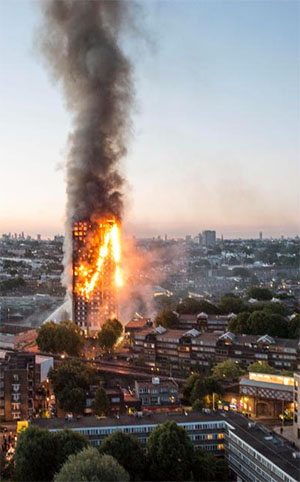
 With this month marking 12 months since the tragic Grenfell Tower fire in London that claimed 72 lives, Evaculife Managing Director Bruce Bromley said the La Crosse building could have easily experienced a similar fate if it were a different time of day.
With this month marking 12 months since the tragic Grenfell Tower fire in London that claimed 72 lives, Evaculife Managing Director Bruce Bromley said the La Crosse building could have easily experienced a similar fate if it were a different time of day.
“A few more sprinkler heads activated, a different time of day, a different wind, the system would have been overrun and we could easily have had our own Grenfell UK disaster.
“What most people do not realise with the La Crosse fire in Docklands is the wind blew the smoke and flames away from the building, and we got lucky in terms of the low water demand in the surrounding area at the time as the number of sprinklers that operated exceeded the design capacity,” he said.
A member of the Standards Australia Development Committee and a former member of the Fire Protection Association Australia Technical & Advisory Committee, Bruce has too often seen the fire dangers of buildings and is urging construction companies to stop putting dollar figures ahead of public safety.
“Aluminium cladding with polyethylene core has been widely used in Australia buildings for the last 40 years due to it ticking the boxes for many builders and construction companies.
“Firstly, it’s cheap, it’s fast to install and it can be installed by anyone with minimal training. It ticks a lot of boxes such as longevity, environmental insulation ratings and low maintenance.
“It also allows for a lightweight façade, which in turn allows for flexibility in design and greater expanses.
“What many don’t realise is fire mitigation is impossible when dealing with this type of cladding. The MFB has stated numerous times that they cannot fight fires above 12 storeys, and providing sprinklers to the outside of buildings doesn’t work, as wind and weather can affect the sprinklers.”
Bruce said removal and replacement is the first option, but who pays for this is likely going to be a sticking point for a number of years.
“The government needs to step in and make removal and replacement mandatory,” he said.
Expanded polystyrene insulation is another widely used, although lesser-known, cheap material which adds to the fire load.
In addition to being a fire hazard, Bruce said both products are prone to melting, dripping and collapsing.
“When burning, polyethylene and polystyrene release two and half times the amount of energy as an equivalent amount of wood,” said Bruce.
Until removal and replacement becomes mandatory, Bruce is urging all developers to consider introducing smoke masks in residential buildings in the event that a fire does occur and smoke fills the space residents can still evacuate.
“Smoke inhalation is the number one killer in a fire situation, toxic smoke kills faster than fire.”
Download Free Personal Emergency Evacuation Plan PEEP Templates


